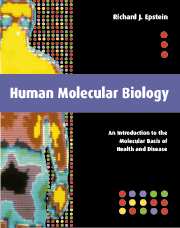Book contents
- Frontmatter
- Contents
- Preface
- Acknowledgements
- Read me first …
- Glossary
- Dedication
- Introduction: A disease for every gene?
- I From molecular biology to human genetics
- 1 Biomolecular evolution
- 2 Chromatin and chromosomes
- 3 Gene expression
- 4 RNA processing and translation
- 5 Protein structure and function
- II From molecular genetics to human biochemistry
- III From molecular biochemistry to human cell biology
- IV From molecular cell biology to human physiology
- V From molecular physiology to human molecular biology
- Index
1 - Biomolecular evolution
Published online by Cambridge University Press: 01 June 2011
- Frontmatter
- Contents
- Preface
- Acknowledgements
- Read me first …
- Glossary
- Dedication
- Introduction: A disease for every gene?
- I From molecular biology to human genetics
- 1 Biomolecular evolution
- 2 Chromatin and chromosomes
- 3 Gene expression
- 4 RNA processing and translation
- 5 Protein structure and function
- II From molecular genetics to human biochemistry
- III From molecular biochemistry to human cell biology
- IV From molecular cell biology to human physiology
- V From molecular physiology to human molecular biology
- Index
Summary
This opening section introduces the terms and concepts needed to understand the topics covered later. We begin by reviewing the fundamentals of molecular action, and then examine how molecules give rise to living systems. The defining structural features of genes and proteins are presented, and the role of these molecules in evolution addressed. Finally, molecular mechanisms contributing to genomic change and adaptation are examined.
Atoms and elements
Sunlight supplies energy for life on Earth
Time began with the Big Bang 14 billion years ago. To begin with all was hydrogen; the next three minutes saw the birth of deuterium and helium through energy-releasing fusion reactions, unleashing the primordial fireball. The resultant formation of stars created a focus for helium consumption, and hence for the energy-dependent intrastellar synthesis of carbon and oxygen.
Ten billion years then passed, during which time our planet formed from the gravity-dependent accretion of asteroidal debris spinning around the Sun. For the next billion years or so there were gales, floods, volcanic eruptions and earthquakes on the Earth – but no life. So why should the miracle of life have since taken root in this humble backwater of the universe?
In fact, there is nothing miraculous about life. The development of life on Earth was probably inevitable; trapped in a stable orbit at a temperate distance from the Sun, the Gaia-like milieu of the planet simply happened to be suitable for molecules to self-select.
- Type
- Chapter
- Information
- Human Molecular BiologyAn Introduction to the Molecular Basis of Health and Disease, pp. 9 - 48Publisher: Cambridge University PressPrint publication year: 2002



